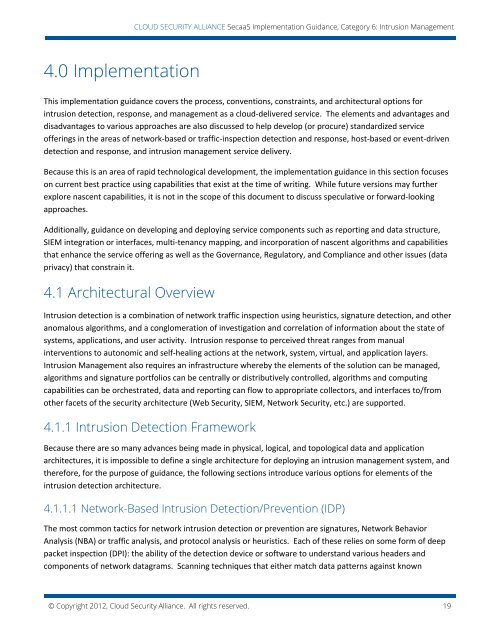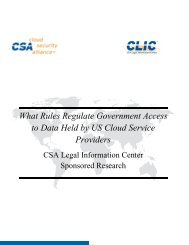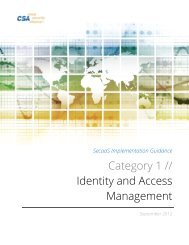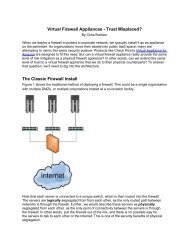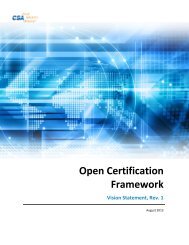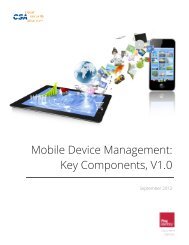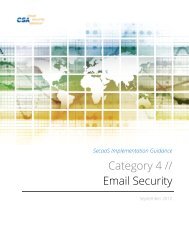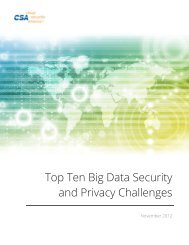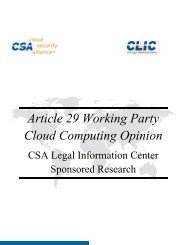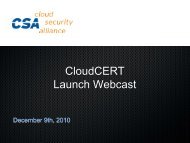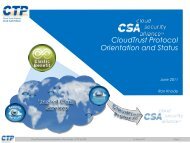Download - Cloud Security Alliance
Download - Cloud Security Alliance
Download - Cloud Security Alliance
- No tags were found...
You also want an ePaper? Increase the reach of your titles
YUMPU automatically turns print PDFs into web optimized ePapers that Google loves.
CLOUD SECURITY ALLIANCE SecaaS Implementation Guidance, Category 6: Intrusion Management4.0 ImplementationThis implementation guidance covers the process, conventions, constraints, and architectural options forintrusion detection, response, and management as a cloud-delivered service. The elements and advantages anddisadvantages to various approaches are also discussed to help develop (or procure) standardized serviceofferings in the areas of network-based or traffic-inspection detection and response, host-based or event-drivendetection and response, and intrusion management service delivery.Because this is an area of rapid technological development, the implementation guidance in this section focuseson current best practice using capabilities that exist at the time of writing. While future versions may furtherexplore nascent capabilities, it is not in the scope of this document to discuss speculative or forward-lookingapproaches.Additionally, guidance on developing and deploying service components such as reporting and data structure,SIEM integration or interfaces, multi-tenancy mapping, and incorporation of nascent algorithms and capabilitiesthat enhance the service offering as well as the Governance, Regulatory, and Compliance and other issues (dataprivacy) that constrain it.4.1 Architectural OverviewIntrusion detection is a combination of network traffic inspection using heuristics, signature detection, and otheranomalous algorithms, and a conglomeration of investigation and correlation of information about the state ofsystems, applications, and user activity. Intrusion response to perceived threat ranges from manualinterventions to autonomic and self-healing actions at the network, system, virtual, and application layers.Intrusion Management also requires an infrastructure whereby the elements of the solution can be managed,algorithms and signature portfolios can be centrally or distributively controlled, algorithms and computingcapabilities can be orchestrated, data and reporting can flow to appropriate collectors, and interfaces to/fromother facets of the security architecture (Web <strong>Security</strong>, SIEM, Network <strong>Security</strong>, etc.) are supported.4.1.1 Intrusion Detection FrameworkBecause there are so many advances being made in physical, logical, and topological data and applicationarchitectures, it is impossible to define a single architecture for deploying an intrusion management system, andtherefore, for the purpose of guidance, the following sections introduce various options for elements of theintrusion detection architecture.4.1.1.1 Network-Based Intrusion Detection/Prevention (IDP)The most common tactics for network intrusion detection or prevention are signatures, Network BehaviorAnalysis (NBA) or traffic analysis, and protocol analysis or heuristics. Each of these relies on some form of deeppacket inspection (DPI): the ability of the detection device or software to understand various headers andcomponents of network datagrams. Scanning techniques that either match data patterns against known© Copyright 2012, <strong>Cloud</strong> <strong>Security</strong> <strong>Alliance</strong>. All rights reserved. 19


